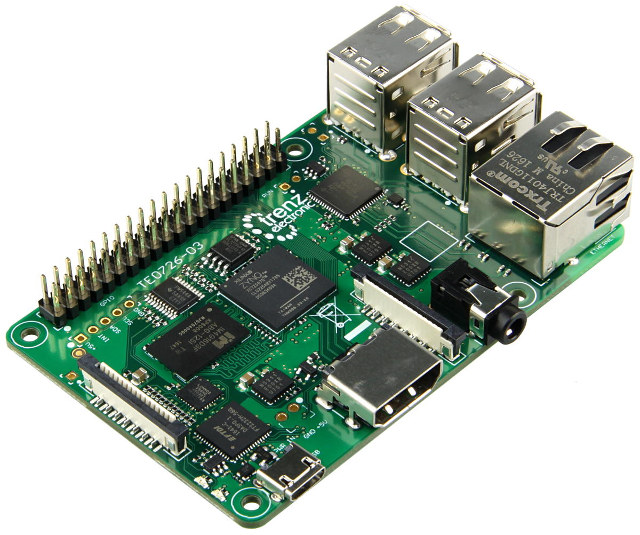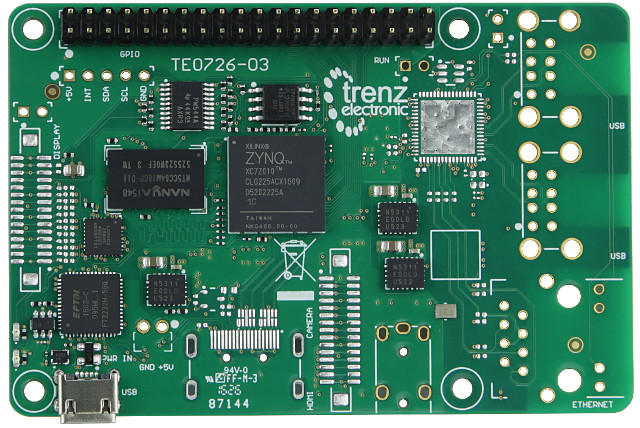Earlier this year, I wrote about Trenz Electronic’s Xilinx Zynq Ultrascale+ system-on-module, but I’ve just found out I missed another interesting product from the company. The ZynqBerry is a board powered by Zilinx Zync Z-7007S or Z-7010 ARM + FPGA SoC with Raspberry Pi 2/3 form factor.

ZynqBerry specifications:
- SoC
- Xilinx Zynq XC7Z007S-1CLG225C (Z-7007S) single core ARM Cortex-A9 MPCore up to 766MHz + FPGA with 23K logic cells
- Xilinx Zynq XC7Z010-1CLG225C (Z-7010) dual core ARM Cortex-A9 MPCore up to 866 MHz + FPGA with 28K logic cells
- System Memory – 128 or 512 MB DDR3L
- Storage – 16 MB Flash SPI flash + micro SD card slot
- Video Output – HDMI, MIPI DSI interface
- Audio Output – HDMI, 3.5mm audio jack (PWM audio only)
- Connectivity – 100 MBit Ethernet via (LAN9514 USB Hub with Ethernet
- USB – 4x USB 2.0 host ports
- Camera – MIPI CSI-2 interface
- Expansion – 40-pin Raspberry Pi compatible header
- Debugging – USB UART and JTAG ARM & FPGA debug via micro USB
- Power Supply – 5V via micro USB port
- Dimensions – Raspberry Pi form factor

Three different hardware versions of the board are available:
- TE0726-03R – Minimal version with Xilinx Z-7010, 128 MB RAM, no Ethernet, no USB, no HDMI, no MIPI connectors – 79 Euros
- TE0726-03M – Xilinx Z-7010 with 512 MB RAM – 109 Euros
- TE0726-03-07S-1C – New model equipped with Xilinx Z-7007S + 512 MB RAM – 99 Euros
The ARM core(s) on the board run PetaLinux, and FPGA part can be programmed using Vivado Design Suite. You’ll find software and hardware documentation, and demos (HDMI, SDR, ALSA, CSI) in the Wiki. Some knowledge of German may be useful in the download area.
ZynqBerry boards can be purchased directly on Trenz Electronic website.

Jean-Luc started CNX Software in 2010 as a part-time endeavor, before quitting his job as a software engineering manager, and starting to write daily news, and reviews full time later in 2011.
Support CNX Software! Donate via cryptocurrencies, become a Patron on Patreon, or purchase goods on Amazon or Aliexpress






Another one… give me please at least one with Mic-Input.
@rebeL
Do you mean an FPGA board with Microphone input, or a Raspberry Pi board with microphone input?
It is a FPGA can you not programme your own mic input.
If someone would port some of the old school computer cores (Amiga/ST/ZX Spec/C64) to this it would sell by the shedload….
Very expensive. For that you get almost 3 RPi.
@Björn
The price is fair. It’s about the same price as a Zturn board also based on Z-7010 SoC – http://www.cnx-software.com/2015/03/03/myir-tech-announces-low-cost-rico-and-z-turn-boards-powered-by-ti-am437x-and-xilinx-zynq-7010-socs/
Also, why not use the integrated Gigabit Ethernet in the SoC? Seems like an choice to go with only 100Mbps on something this expensive.
@rebeL
Heard this a lot, seems that very few people knows about the existence of USB mics
@James Youngs
You can emulate them in software on a £25 Android TV box. Goggle Play store full of emulators and many free.
Why would they use USB-Ethernet? Zynq has two RGMII ports.
@theguyuk Emulation NOT same as Simulation (FPGA)… I know you can emulate on Android box or Pi or PC or even PS3 etc
@James Youngs
We can play words of symatics but if don’t know how it is done you mostly cannot tell.
A Arduino replaces many components buy running software commands instead of physical connection and can be reprogrammed by updating or replacing the original programme. No different than a Soc running the firmware in a product.
Don’t forget parallela boards, with Zynq dual core and at least 512MB for 99$ + a dedicated 16core array processor. It had some community and the designers are very knowledgeable.
@cnxsoft
Thanks for answer, I´m looking for a board which has one (stereo) native Mic-Port not a “simulate”, because of seriously working with it. I´m a hearing aid master, looking for open system, Linux would be nice!
@rebeL
They are plenty of boards with mic input via the headphone jack, or using built-in microphone, so I assume you’d like to use your own (high quality) microphone with a dedicated microphone input not shared with audio output, and not too much hardware hacking using I/O headers.
With that in mind, I did a search on this blog for “mic input” and “microphone input”, and one solution would be to use a Raspberry Pi Hat like that Suptronics X200: http://www.cnx-software.com/2014/11/12/suptronics-x200-raspberry-pi-model-bexpansion-board-adds-wi-fi-rtc-vga-optical-spdif-usb-ports-servo-support-and-more/
@James Youngs
Have you seen ZX-Uno? It features all those cores and much more… http://zxuno.speccy.org/index_e.shtml
@jerry
I saw it a while back and must have put out of my mind. Its great for 8 bit but I’d also want to do 16-bit like ST/Amiga/Megadrive…. The ST and Amiga were the first 2 I asked if this board might be suitable for….
@cnxsoft
The Suptronics X200 is sold out erverywere I was looking for, sadly I don´t have a credit card, aliexpress I can´t use.
@rebeL
I’ve just seen that. They have other models with mic input like X205 or X300, but they don’t seem easy to find either.
A13-OlinuXino board also comes with mic input (not sure mono or stereo): https://www.olimex.com/Products/OLinuXino/A13/A13-OLinuXino/open-source-hardware